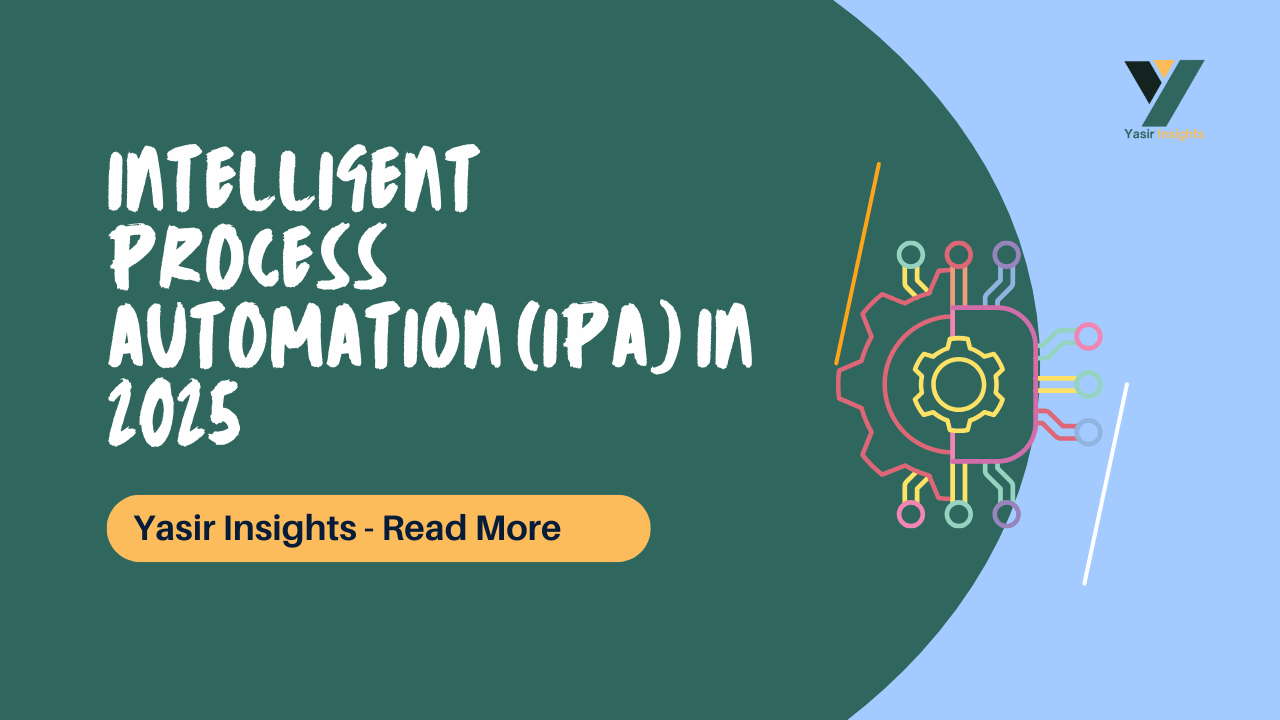
As we move into the digital age, businesses are being forced to reconsider how they conduct their business, and the fastest thing to do is to use artificial intelligence. As companies are under increasing pressure to boost sales, enhance customer happiness, and deliver faster services, intelligent process automation, or IPA, is emerging as a disruptive force. By integrating the capabilities of robotic process automation, machine learning, artificial intelligence (AI), and natural language processing, IPA is revolutionising businesses by automating complex, time-consuming operations. Human talent may now focus on strategy and innovation as a result.
We’ll go over what IPA is, how it varies from conventional RPA, its revolutionary advantages, and how your company may adopt this shift in 2025 in this in-depth guide from Yasir Insights.
Also Read: What is Prompt Engineering?
Intelligent process automation (IPA) is the use of artificial intelligence technologies, such as robotic process automation (RPA), natural language processing (NLP), and machine learning, to enhance, analyse, and streamline business processes, all these fields are the fundedamental of fastest and the smartest approach in the field of technology.
IPA is not exclusively dependent on rule-based reasoning; in contrast to conventional automation solutions, this field is one of the best and smartest in the world of tech and AI. With less human input, it can make more intelligent, context-aware judgements by comprehending unstructured material, such as text and images.
Also Read: Google Unveils Ironwood: A Giant Leap in AI Inference Power
The landscape of automation has evolved. Basic bots can’t keep up with dynamic business environments. Enter IPA: a smarter, more adaptable solution. Here’s what makes it essential:
Works with unstructured data like images, emails, or scanned documents
Learns and improves over time using machine learning algorithms
Reduces operational costs and increases efficiency
Enhances decision-making by providing predictive insights
Also Read: Generative AI vs Discriminative AI
Task Type
RPA: Performs repetitive, rule-based tasks
IPA: Handles complex, cognitive tasks
Data Type
RPA: Works only with structured data
IPA: Works with both structured and unstructured data
Intelligence
RPA: No artificial intelligence involved
IPA: Uses integrated AI and machine learning
Adaptability
RPA: Low adaptability; requires reprogramming for changes
IPA: Highly adaptable to changes and exceptions
Learning Ability
RPA: Cannot learn or improve on its own
IPA: Learns and improves over time through machine learning
Also Read: AI vs Machine Learning vs Deep Learning vs Neural Networks
Artificial Intelligence (AI): Powers decision-making by identifying patterns and insights.
Robotic Process Automation (RPA): Automates repetitive, high-volume tasks.
Machine Learning (ML): Continuously improves accuracy and outcomes through training.
Natural Language Processing (NLP): Enables interaction with text and spoken language.
Computer Vision: Extracts data from images and scanned documents.
Also Read: Scope of Artificial Intelligence in Pakistan
IPA tools can process unstructured data, extract key insights, and convert it into actionable information. For instance, it can scan invoices and update accounting systems instantly.
By automating repetitive tasks, businesses can reduce manual labour, minimise errors, and allocate resources more strategically, ultimately lowering costs and increasing ROI.
IPA doesn’t rely on static rules. With repeated usage, it becomes more accurate and dependable as it develops through data exposure, because data is one of the important things and assets in the technology field.
Businesses can provide better and faster customer service with speedier processing, personalised replies, and continuous availability.
Also Read: What is Machine Learning?
Finance: Automated fraud detection, transaction processing, and customer onboarding
Insurance: Claims processing, policy management, and customer support
Healthcare: Patient record digitisation, appointment scheduling, and billing automation
Logistics: Shipment tracking, route optimisation, and inventory management
Human Resources: Resume screening, onboarding, and employee record updates
Also Read: Which Is Easy Cybersecurity Or Artificial Intelligence?
At Royal Exchange General Insurance Company, outdated paper-based systems and delayed approvals slowed their processes. By implementing an IPA solution, they:
Reduced approval cycles from days to minutes
Automated 70% of operations
Processed over 500 claims in just 3 months
This transformation highlights how IPA can completely reshape operational workflows.
Also Read: Best Tools for Practicing Programming or Coding in 2025
Map Existing Processes
Begin by understanding and documenting your current workflows.
Choose the Right IPA Tools
Platforms like Kissflow, UiPath, and Automation Anywhere offer powerful IPA solutions.
Redesign Your Processes
Reengineer inefficient workflows to take full advantage of automation.
Integrate and Train
Connect systems, train teams, and iterate based on feedback and performance data.
Monitor and Scale
Use real-time analytics to track results and scale automation across departments.
Also Read: Top Best AI Tools to Use in 2025
Hyperautomation—an evolution of IPA—takes automation a step further by integrating even more advanced tools like blockchain, IoT, and edge computing. These technologies pave the way for really autonomous businesses by facilitating self-optimising procedures and real-time decision-making, all the things help in the betterment of business and organisation.
Also Read: How to Learn Artificial Intelligence in 2025 From Scratch
The goal of Intelligent Process Automation is not to replace humans but to enable them to focus on what truly matters—creativity, innovation, and strategic decision-making. As we step into 2025, adopting IPA is no longer a luxury but a necessity for companies that wish to stay competitive.
Also Read: Top 10 Programming Languages to Learn in 2025
Q: Is Intelligent Process Automation suitable for small businesses?
Yes! IPA solutions are scalable and can be customised based on business size and needs.
Q: Do I need to have AI experts on my team to use IPA?
Not necessarily. Many IPA platforms offer user-friendly interfaces and pre-built models that don’t require coding or AI expertise.
Q: How long does it take to see results from IPA implementation?
You can begin seeing improvements in workflow speed and cost savings within weeks of implementation, depending on the process.
Q: What’s the difference between IPA and AI?
AI is one of the technologies within IPA. IPA uses AI to enhance automation by making decisions and processing unstructured data.
Also Read: What Is Web Development?

